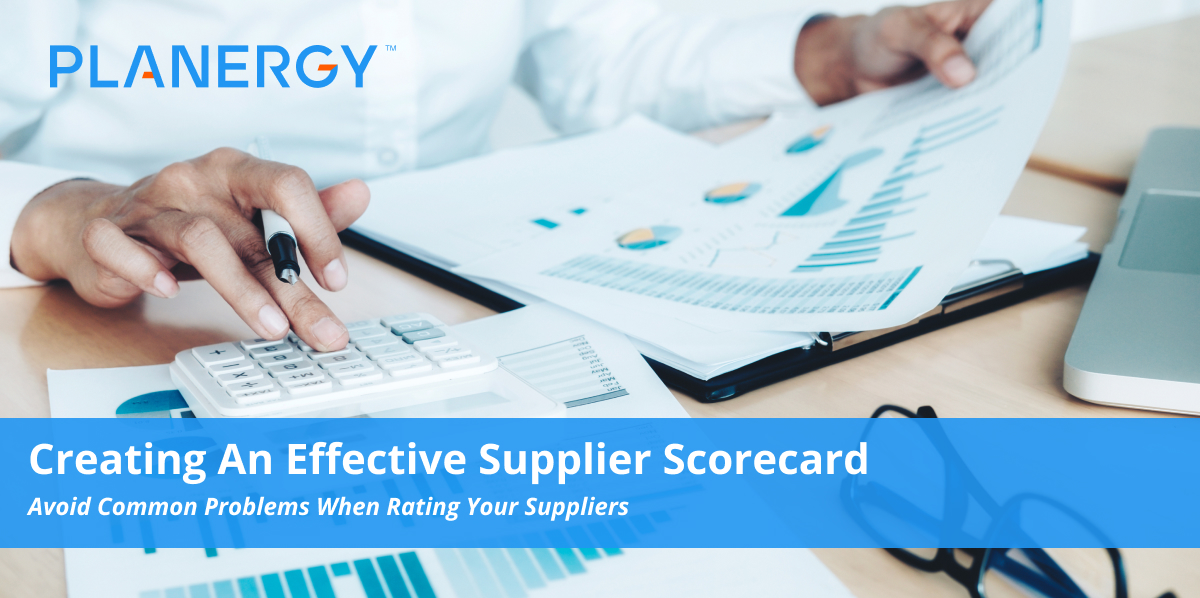Is your organization tracking comparative performance metrics to build vendor relationships and maximize supply chain efficiency?
Procurement departments have a primary responsibility to evaluate, identify, and monitor the best possible suppliers based on criteria that meets the needs of the business. Supplier management and maintaining good supplier relationships are key tasks for the procurement team. Supplier performance scorecards are tools used by organizations to evaluate and track how suppliers perform their contracted obligations, and measure how well they stack up against competitors.
Sharing well-defined scorecard system with suppliers helps the procurement department maintain an updated list of preferred suppliers and incentivizes suppliers to improve in important areas to make or remain on the preferred list. Vendor relationships strengthen and become more mutually beneficial; as suppliers align their internal processes with company objectives, additional business opportunities arise. For example, a vendor that offers faster delivery could rise in the ranking by focusing on more competitive pricing or higher quality materials.
Obtaining executive buy-in can be challenging. The most effective argument explains how improving supplier performance supports company objectives, goals, and success strategies by exposing hidden cost drivers, mitigating risks, improving performance levels and enhancing productivity, and ensuring that company values and vendor compliance are in place.
Evaluation Factors
How key performance indicators (KPIs) are weighted depends on company objectives. For example, some companies build their reputation around sustainable materials, making quality sourcing more important than lowest price.
To determine supplier quality evaluation factors, begin by listing goals and objectives by level of importance. A big box store chain like Walmart might consider price, quantity, and availability top criteria, while the reputation of businesses such as The Honest Company rely on environmentally friendly ingredients and ethical sourcing. Even within the same industry, the assigned importance of each factor might be radically different between competing companies.
The key to creating an effective supplier performance scorecard lies in the methodology used to determine criteria. Cookie-cutter KPI won’t work. Evaluation metrics must be weighted according to company goals, business objectives, and procurement strategies.
Common Supplier Scorecard Criteria
With company goals and objectives as they relate to vendor performance defined and prioritized, scorecard assembly can begin. Most organizations will have intersecting performance measurement criteria, arranged by differing order of importance. Here’s a list of common factors:
Quality
For nearly every organization, quality of goods and services is high on the list. An organization is only as good as the quality of raw materials, services, or products intended for sale that comprises what is presented to the customers. Quality assessment includes whether the product meets the standards outlined in the contract, the condition it is delivered in, the rate of return (customer satisfaction), whether the product meets sales projections.
In the case of raw materials, for example in the construction industry, poor quality raw materials can lead to building foundations that do not meet safety compliance standards, which can quickly compromise any project.
Even when choosing technology intended to enhance productivity, evaluating performance criteria can be critical to success. Adopting software systems that do not meet company needs or are too difficult for easy adoption can result in the exact opposite of the intended purpose, adding man-hours, reducing visibility, and forcing workarounds as employees struggle to cope.
Delivery/Lead Time
It can be challenging at first to nail down delivery times. From a supplier’s point of view, delivery is when a shipment leaves the warehouse. From the receiver’s point of view, it is when the goods are received and logged. Delivery metrics should be tracked and evaluated over time, to ensure that suppliers deliver as expected and timelines are met. Comprehensive procurement software offers the tracking data necessary, as defined by whatever parameters are set.
Pricing/Cost
While every business wants the lowest possible price and pricing is on nearly every charted example, it is not necessarily a metric that should be included. Unless your brand is built on cheap pricing, cost should not be the priority. In a recent article for Industry Week, Founder & President of Pathways to Manufacturing Excellence Larry Fast advises that pricing should not be included in supplier evaluation, since price negotiation depends on external market forces and has no part in improving processes to excel.
Capability
Can the supplier consistently provide the volume of product necessary? Monitoring the financial stability, production capability, and adaptability of suppliers factors into mitigating associated supply chain risks.
Ethical Sourcing
Ethical sourcing plays an increasingly important role in competitive business strategy. Gartner identifies corporate social responsibility (CSR) as a “key market differentiator for businesses as more consumers look to purchase products from companies that act responsibly.”
This list of considerations is in no way exhaustive. For each individual organization, achieving a balanced scorecard depends on the specific needs, budget, and objectives defined by the organization. Other considerations may include innovation, new product development, communication, corrective actions response time, or flexible delivery methods.
Within each broad category, more specific breakdowns can be assigned weight for a total score for that metric.
Define Expectations
Most businesses narrow the list to four or five key points and ask preferred suppliers to work on improving in those areas for mutual benefit. Using the criteria, supplier performance expectations and actionable goals can be set for ongoing supplier evaluation.
After defining the broad categories and weighting factors in relation to importance, define specific, measurable metrics for tracking. Scorecard metrics methodology should clearly state what defines good, acceptable, and unacceptable performance limits for each category.
Partnering with Major Suppliers to Improve Metrics
Finally, to ensure the success of a vendor scorecard program, organizations can actively participate in helping major suppliers craft an actionable plan for continuous improvement.
By aligning scorecard metrics with business goals and objectives, and communicating performance expectations and evaluations internally and with suppliers, procurement managers can significantly improve supply chain efficiency. Vendor scorecards also provide a baseline comparison when seeking new suppliers. Procurement managers can minimize risk by seeking new suppliers with intent to fill gaps where current suppliers may fall short.




